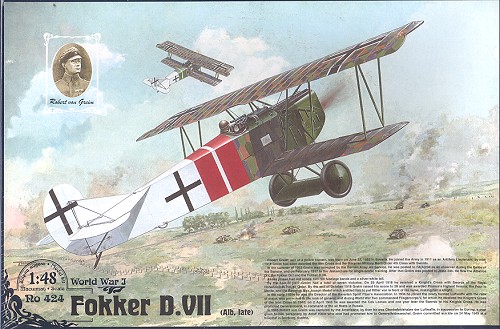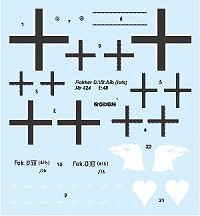
| KIT: | Roden 1/48 Fokker D.VII (Albatros-Late) |
| KIT #: | 424 |
| PRICE: | $19.98 (17.96 at Squadron) |
| DECALS: | options |
| REVIEWER: | Scott Van Aken |
| NOTES: |

| HISTORY |
Thanks to www.rodenplant.com for the historical background.
| THE KIT |
Roden definitely knows how to get the most out of its molds. The Fokker D.VII is a prime example of this. The D.VII was built by several different companies during its rather short production life. When you add that to the variations between early and late airframes, you have several different boxings. This brings about two things. One is that there are a lot of rather small parts as bits of the airframe are molded separately to take care of the differences. The other is that the modeler is given the most accurate representation of that variant possible rather than to have to make alterations to an existing airframe to incorporate the changes.
This particular version is for those later D.VIIs produced by Albatross. Now you are probably looking at the image of the parts and wondering just what is different from the previous boxings. Roden has incorporated multiple bits on the standard sprues and as you can see, there are two engines, two exhaust, three props, three wheels, three gear spreader bars in those sprues. What is different amongst the kits is the top center sprue that has the forward engine panels and radiator. This is what allows the builder to do the variant that is boxed.
As with all of Roden's kits, this one
is well detailed with very fine parts that need care to remove from the
sprues. The parts in this kit are very clean with no flash, no obvious sink
areas and only a few ejector towers to remove. The instructions are quite
good providing color information in generic terms and Humbrol color
references. Markings are provided for three aircraft. These
are:

Fokker D.VII (Alb) late, w/n unknown, flown by Oblt. Robert von Greim, Jasta 34b CO, Masnieres, September 1918. This is the box art aircraft
Fokker D.VII (Alb) late, w/n unknown, flown by Ltn. Frodien, Jasta 40, mid 1918.
Fokker D.VII (Alb) late, w/n unknown, flown by Ltn. Willi Rosenstein, Jasta 40, mid 1918. These last two have basically black fuselages with white tail sections.
The decals are very nicely printed and if they are the new Roden decals, they should go on with almost no problems at all.
| CONCLUSIONS |
Most modelers are pretty jazzed about all the great WWI kits coming from Roden. Not only are they very well done, but they manage to do all the different variants, and that adds a lot to being able to do a line-up of D.VIIs on the shelf!
July 2005
You can find this kit and many others at

If you would like your product reviewed fairly and fairly quickly by a site that has around 300,000 visitors a month, please contact me or see other details in the Note to Contributors.